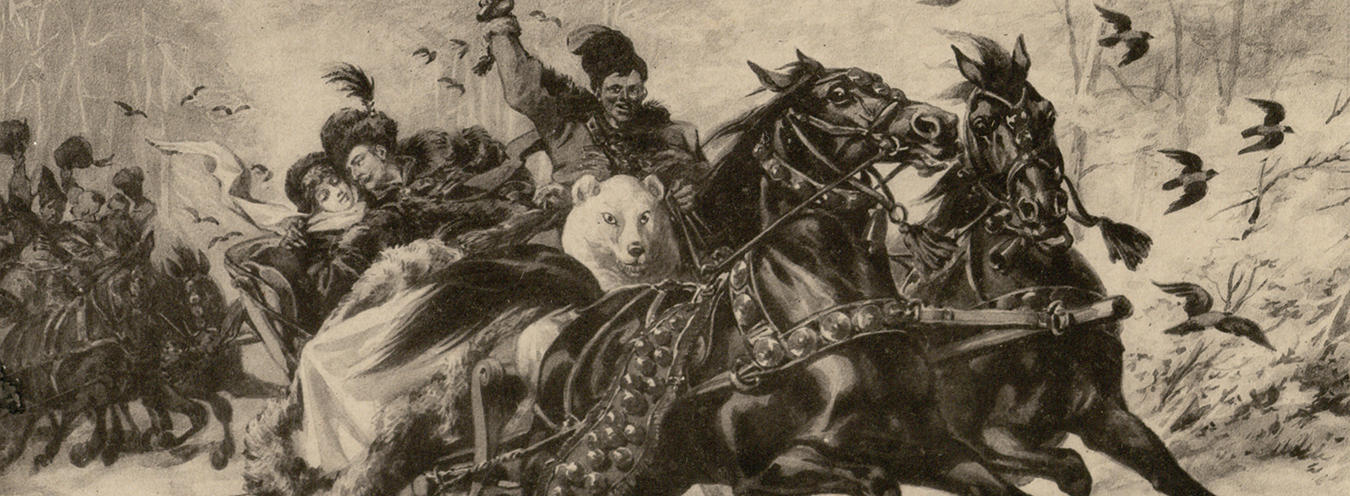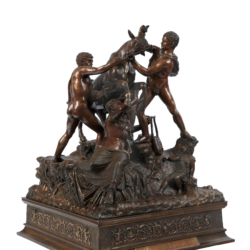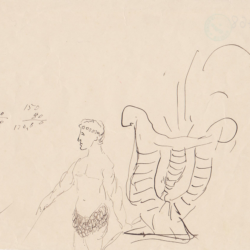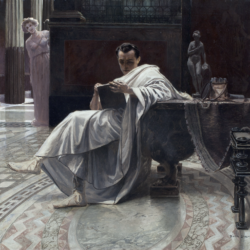
Hercules at Omphale’s feet
Sienkiewicz’s inversion of the herculean myth, as discussed in this sketch, refers to the already mentioned softness of the image, loaded with ambivalent meanings, and full of mysterious and disturbing charm, which are evoked by the mythological image of Hercules at Omphale’s feet.[1] Let us summarize the traditional story: as punishment for the murder of innocent Iphitus, mythological Hercules had to spend three years as a servant at the court of Queen Omphale, the ruler of Lydia – the country with a cultural inversion of sexual roles. Having bought Hercules as a slave, Omphale took over the hero’s attributes: the lion skin and the club, and the hero, dressed in women’s clothes, spun the wool. What is significant in the modern references to this myth is that the two were also joined by fierce passion.
At this point, it is worth mentioning a characteristic thread, discussed by Ryszard Koziołek, in The Deluge (Potop),[2] where the heroic Kmicic, excluded from the community of men due to his dishonorable deed, in a way, imitates the ideal represented by Oleńka, the impersonation of the virgin-hero. In his own way, Kmicic-Babinicz, develops the mythical herculean theme of role reversal, dressing up in peasants’ clothes.
The transgressive, even masochistic, theme of Hercules at Omphale’s feet ignited the imagination of many 19th-century writers – it is enough to mention Théophile Gautier,[3] Stendhal, or August Strindberg (The Father).[4] In Polish literature, Joachim Lelewel devoted his attention to this theme in reference to Sebastian Ciampi’s work on Greek sculpture. He became involved in an argument with the scholars who were searching for Omphale’s theme in the scene of the triumph in Meropamikos. Lelewel confirmed that the Greek amethyst did not contain (as claimed Ciampi) the “veiled” head of Helenus, but Hercules’ head, “decorated in a womanly way in order to celebrate the orgy with Omphale.” [5] In post-January-Rising poetry, this theme was taken up, for instance, by Marian Korwin-Kochanowski in his erotic poem “Konwalia” (Lily of the Valley).[6] What is more, the theme of Hercules’s effeminacy was noticed by Teodor Jeske Choiński as the syndrome of “disintegration in life and literature,” already confirmed in Roman civilization (the author quoted the example of the satire “The Dialogues of the Gods” by Lucian of Samosata).[7]
This last theme, concerning the “disintegration of Roman civilization,” which was discussed in the literature and in the literary criticism of the late 19th century interferes more subtly with Sienkiewicz’s representation of the antique world presented in Quo Vadis. This is connected, to a large extent, with the figure of “slender and effeminate” Petronius.[8] But there are more such figures: the ill fate of Omphale’s distaff also affected Vinicio, “a handsome athletic youth.”[9] In one of the variants of herculean myth, which was employed in Quo Vadis, the theme of dressing the protagonist up in slave’s clothes, which were unworthy of him, loses the meaning of a frivolous anecdote and the explicit nature of a sexual joke concerning the reversal of roles, the game of domination and submission. In Quo Vadis, Marc Vinicio dresses up as a slave, but this disguise has a hidden meaning; it contributes to the process of internal development of the protagonist to the role inspired by the role model of Ligia (“On his part, Vinicio, disguised as a slave, was searching for Ligia all day, in the backstreets of the town, but he did not manage to find the smallest trace or a cue”).[10] His disguise as a slave – as we might think – let the hero of the twilight of the world of antiquity find the way to the world of Christianity, with its ideal of humility. The scene of Vinicio watching the “living torches” of Nero acquires a symbolic significance:
And so they saw Hercules, burning alive, on the top of Mount Oeta. Vinicio shuddered at the thought that Ursus may have been assigned the role of Hercules, but it seemed that it was not the turn of Ligia’s faithful servant because some other Christian whom Vinicio did not know burnt on the stake.[11]
Something, someone must die so that a new hero worthy of a new era can be born.
Przypisy
- See e.g. P. Grimal, “Hercules,” The Dictionary of Classical Mythology, translated by A. R. Maxwell-Hyslop, Hoboken, New Jersey 1996.
- R. Koziołek, op. cit.
- On Gautier’s Omphale, 1835 – see B. Sosień, “Lwia skóra, maczuga i kądziel: Herkules, Omfale i rokoko (Théophile Gautier: Omphale, 1835)” [The lion’s skin, the club and the distaff: Hercules, Omphale and Rococo (Théophile Gautier: Omphale, 1835)], in Prace Herkulesa – człowiek wobec wyzwań, prób i przeciwności [Hercules’s labors – man in the face of challenges, trials and adversities], pp. 175–184.
- See P. Noir, Aux pieds d’Omphale. Hercule ou le crépuscule d’un dieu masochiste (Mythocritique de la Décadence et de Sacher-Masoch), Paris 2014.
- J. Lelewel, “O pracach profesora Ciampi z uwagą nad rzeźbą wyrażać mającą głowę Herkulesa w stroju Omfalii oraz z notką nad wyrazem Equitas” [On the works of Professor Campi regarding the sculpture of Hercules’ head in Omphale’s dress, including the note on the word Equitas], in Polska, dzieje i rzeczy jej [Poland: History and concepts], vol. 18/2, Poznań 1865, pp. 133–135; trans. E. N.
- See the poem of this poet, entitled “Konwalia” (The Lily of the Valley). There, the following confession takes place: “And I am not the same – alone, without Omphale.” See M. Korwin-Kochanowski, “Konwalia” [The Lilly of the Valley], in Wydanie pośmiertne pieśni i poematów [Posthumous collection of songs and poems], Kraków 1869, p. 12.
- In the dialogue cited by Jeske-Choiński, Esculapius sneers at Hercules, “After all, if I did no great deed, but at least I was not a lackey, like you were; I did not spin wool in Lydia, I did not wear a purple skirt, and I did not get my face bitten with Omphale’s golden shoe.” (T. Jeske-Choiński, Rozkład w życiu i literaturze. Studium [Disintegration in life and literature: A Study], Warsaw 1895, pp. 11-12; trans. E. N.
- Dzieła [The Collected Works], vol. 20, p. 53.
- Dzieła [The Collected Works], vol. 20, p. 2.
- Dzieła [The Collected Works], vol. 22, p. 135.
- Ibidem, p. 147.








